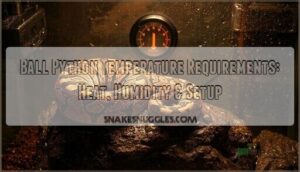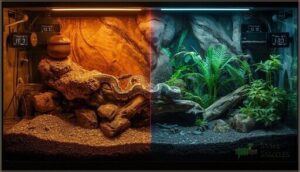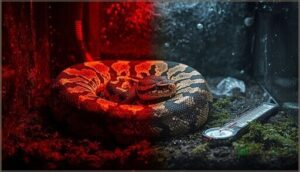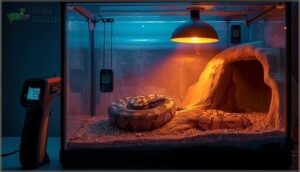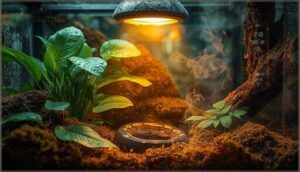This site is supported by our readers. We may earn a commission, at no cost to you, if you purchase through links.
Your ball python’s survival hinges on precision, not guesswork, because these ectothermic reptiles can’t generate their own body heat and depend entirely on their environment to regulate critical bodily functions. When temperatures drop below 75°F or spike above 95°F, you’re not just creating discomfort—you’re compromising digestion, weakening immune responses, and inviting respiratory infections that can prove fatal within days.
Understanding ball python temperature requirements means recognizing that your enclosure isn’t just a habitat but a carefully controlled thermal ecosystem. Even a five-degree miscalculation can trigger stress responses that manifest as feeding refusal, lethargy, or chronic illness.
The difference between a thriving snake and one struggling with health complications often comes down to how well you’ve established thermal gradients, selected appropriate heating equipment, and maintained consistent monitoring protocols.
Table Of Contents
- Key Takeaways
- Ball Python Ideal Temperature Ranges
- Importance of Thermal Gradients
- Best Heating Methods for Enclosures
- Monitoring and Maintaining Temperatures
- Humidity’s Role in Temperature Control
- Frequently Asked Questions (FAQs)
- What temperature is too cold for a ball python?
- Can you leave a heat lamp on 24/7 for ball python?
- Is 90 degrees too hot for a ball python?
- What temperature should a ball python’s cage be?
- Is 95 degrees too hot for a ball python?
- What size enclosure for a baby ball python?
- How often should I spot clean?
- Can I use a heat lamp and heat mat?
- What substrate is best for humidity?
- My ball python isnt shedding properly; why?
- Conclusion
Key Takeaways
- Ball pythons require a precise thermal gradient with warm side temperatures between 88-92°F and cool side temperatures between 75-80°F, as even five-degree deviations can trigger stress responses, feeding refusal, and compromised immune function.
- Establishing distinct temperature zones throughout the enclosure allows ball pythons to thermoregulate naturally by moving between areas, which directly impacts their digestion, metabolism, and ability to maintain homeostasis.
- Ceramic heat emitters and overhead heat lamps paired with thermostat-controlled systems provide safer, more reliable heating than heat rocks or unregulated under-tank pads, which pose significant burn risks and thermal injury hazards.
- Humidity levels between 50-60% must be maintained alongside proper temperatures because moisture-laden air affects heat retention and your python’s thermoregulatory efficiency, with both factors requiring continuous monitoring through calibrated digital sensors.
Ball Python Ideal Temperature Ranges
Your ball python’s health depends on maintaining precise temperature zones throughout its enclosure, which means you’ll need to establish several distinct thermal areas that allow your snake to thermoregulate naturally.
These temperature requirements aren’t just guidelines—they’re essential parameters that directly impact your python’s digestion, immune function, and overall well-being.
Let’s examine the specific temperature ranges you need to maintain in each zone of your ball python’s habitat.
Warm Side Temperature
Your ball python’s warm side should maintain a temperature range between 85 and 92 degrees Fahrenheit, with basking spots reaching 88 to 92 degrees to support digestion and metabolic function. Heat sources must be controlled through thermostats to prevent thermal burns, as surface temperatures exceeding 95 degrees pose serious risks.
Digital thermometers provide essential temperature control, ensuring your setup creates a safe, effective thermal gradient. Maintaining precise temperatures is vital for the health of your ball python, and understanding methodological rigor in scientific studies can inform better care practices.
Cool Side Temperature
While your warm side provides heat for digestion, the cool zone allows your snake thermoregulation through ambient control at 75 to 80 degrees Fahrenheit. Temperature gradients depend on this thermal comfort range:
- Maintain cool side temperatures between 75 and 80°F using digital thermometers
- Keep the thermal gradient distinct—avoid letting the cool zone exceed 82°F
- Monitor temperature control with thermostats to prevent drops below 70°F
Proper temperature range management ensures healthy snake thermoregulation behavior. For best results, consider the reptile care guidelines when setting up your Ball Python’s enclosure.
Basking Surface Temperature
Your basking surface temperature should sit between 90 and 95°F, measured directly on the substrate with digital thermometers or infrared readers. This creates a vertical thermal gradient that allows your python to absorb heat through direct contact.
Use thermostats to maintain consistent heat sources, and map the thermal gradient to confirm your surface materials aren’t insulating or dissipating warmth excessively, which compromises thermal safety and temperature calibration.
Nighttime Temperature
Once darkness falls, your thermal gradient still matters—nocturnal heat zones must remain accessible while preventing cold stress from excessive thermal drops.
Maintain warm-side temperatures above 88°F and cool-side minimums near 75°F, ensuring overnight safety through calibrated digital thermometers and reliable thermostats.
Monitor these nighttime gradients carefully, as prolonged exposure below 75°F compromises metabolic function and increases hypothermia risk in captive individuals relying on your heat sources.
Importance of Thermal Gradients
Your ball python can’t regulate its body temperature the way you do, which means it relies entirely on the environment you create to stay healthy. A proper thermal gradient—where one side of the enclosure is warmer and the other is cooler—gives your snake the freedom to move between zones and find the temperature it needs at any given moment.
Ball pythons rely entirely on the thermal gradient you create to thermoregulate and stay healthy
Understanding why this gradient matters, how to set it up correctly, and what happens when you get it wrong will help you avoid common mistakes that put your python at risk.
Thermoregulation for Ball Pythons
Your ball python doesn’t passively accept whatever temperature you provide—it actively seeks the warmth or coolness it needs to maintain homeostasis, a process called thermoregulation. By moving between zones, the snake regulates digestion, metabolism, and stress levels, making a proper thermal gradient essential.
Without adequate heat sources and a reliable thermostat to maintain thermal balance, environmental factors compromise normal snake behavior and physiological function.
Creating Proper Temperature Zones
To establish functional thermal gradients, you need a warm zone with surface temperatures between 32–35°C and a cool zone ranging from 24–28°C, creating a span of roughly 10–15°C across the enclosure.
Position your heat source and thermostat to maintain consistent zone management, ensuring your ball python can relocate between areas for proper heat distribution and thermal cycling without abrupt temperature shifts.
Risks of Incorrect Gradients
Thermoregulation failure emerges when your enclosure’s thermal gradient collapses, triggering cascading physiological complications that compromise your ball python’s health and longevity through disrupted metabolic processes.
- Inadequate warm side dominance elevates chronic stress levels, suppressing appetite and causing progressive weight loss in your python.
- Excessive cool side temperatures prevent effective digestive processes, increasing dehydration risks through prolonged activity periods.
- Improper basking surfaces cause thermal burns or overheating injuries from unregulated heat sources.
- Temperature fluctuations disrupt normal digestion and metabolism, escalating malnutrition and impaction risks.
- Inconsistent nighttime temperatures compromise immune function, heightening vulnerability to parasitic infections and disease.
Best Heating Methods for Enclosures
You’ll need to choose the right heating equipment to maintain those temperature gradients your ball python depends on for healthy thermoregulation.
Several heating methods are commonly used in reptile husbandry, but they each offer different advantages and present unique safety considerations that you should understand before setting up your enclosure.
The following options represent the most reliable and widely recommended heating solutions for ball python keepers.
Under-Tank Heating Pads
Under-tank heating pads serve as supplementary heat sources rather than primary reptile heating solutions, warming localized floor surfaces while contributing minimally to ambient air temperature in larger enclosures.
You’ll need a thermostat to prevent overheating, as unregulated heat mats routinely exceed safe temperatures and pose burn risks.
Substrate depth over the pad greatly affects heat transfer—approximately one inch allows effective warming—while proper thermostat settings and pad maintenance guarantee energy efficiency and long-term safety.
Ceramic Heat Emitters
Ceramic heat emitters radiate infrared heat without visible light, making them excellent reptile heating options when you need consistent warmth around the clock.
You’ll want to pair your emitter with a thermostat to regulate intensity and prevent overheating, ensuring proper heat distribution across your thermal gradient.
Emitter placement matters—mount it overhead with adequate clearance to maintain ceramic safety while avoiding burns or fire hazards in your enclosure.
Heat Lamps and Overhead Heating
Heat lamps deliver overhead heating that mimics natural basking conditions, but lamp placement requires precision to avoid thermal burns while maintaining an effective thermal gradient. You’ll want to combine your heat source with a heat mat if needed, ensuring proper heat distribution across the 88–92°F warm zone.
Always use thermostatic control for heat lamp safety, and remember that standard heat lamps don’t provide UVB lighting—that’s a separate consideration.
Heat Rocks and Safety Concerns
While overhead heating offers natural warmth, heat rocks present serious burn risk factors and should never be used for ball pythons. These devices concentrate heat on small contact surfaces, causing thermal injuries to your snake’s ventral scales, mouth, and tongue.
Heat rock alternatives like heat mats paired with a reliable thermometer and thermostat maintain a safer thermal gradient without the risk of localized hotspots or equipment failures.
Monitoring and Maintaining Temperatures
You can’t simply set up your ball python’s heating equipment and walk away—accurate monitoring is the backbone of safe temperature management. Without the right tools and techniques, you won’t know if your snake is truly getting the warmth it needs to thrive.
Here’s how to measure, track, and adjust temperatures throughout the year to keep your python healthy.
Using Thermostats and Thermometers
Without reliable digital sensors and thermostats, you can’t maintain the thermal gradient your ball python needs to thermoregulate safely. Temperature probes placed at both ends of the enclosure—attached to each heat source—deliver the accuracy settings necessary for precision temperature control, while thermometer calibration verifies readings stay within ±1–2°C of target ranges.
- Position temperature probes directly on basking surfaces and cool-side substrate to capture real thermal conditions at snake level.
- Use digital thermostats with dual-zone capabilities to regulate both warm-side and cool-side heat sources independently.
- Calibrate your thermometer monthly against a known standard to prevent drift that compromises accuracy settings.
- Check thermostat calibration quarterly to verify high-limit cutoffs prevent dangerous overheating events.
Measuring Surface Vs. Ambient Temperatures
Accurate sensor placement distinguishes surface readings from ambient air temperature, and that difference matters—surface probes pressed directly against basking spots or substrate capture heat transfer at contact points, while ambient thermometers positioned at snake level measure the surrounding air your python moves through.
Surface readings often run 1–3°C cooler than ambient values, so monitoring both with calibrated thermometers ensures your thermal gradient and temperature control deliver true thermal accuracy across each heat source zone.
Adjusting for Seasonal Changes
Seasonal shifts in room temperature demand gradual adjustments. Drop your enclosure targets by 2–4°C in winter while preserving the warm basking zone, then raise ambient temperatures 1–3°C come summer to offset heat buildup.
Implement temperature fluctuations over one to two weeks using a programmable thermostat for thermal cycling. Monitor humidity control closely, as moisture levels influence thermal gradient stability and shedding success throughout the year.
Humidity’s Role in Temperature Control
You mightn’t realize it, but humidity and temperature work hand-in-hand inside your ball python’s enclosure, and getting one wrong can throw off the other.
When moisture levels climb too high or drop too low, your heating system has to work harder to maintain those critical thermal zones, and your snake’s ability to thermoregulate effectively gets compromised.
Understanding how these two environmental factors interact will help you create a more stable, comfortable habitat that fosters your python’s long-term health and well-being.
Ideal Humidity Levels for Ball Pythons
You’ll want to maintain a relative humidity of 50 to 60 percent for most of the year, supporting ideal respiratory function, skin health, and thermoregulatory behavior through proper humidity management for reptiles. Environmental balance becomes critical during the shedding process, when you can raise humidity to 60–70 percent temporarily, then return to baseline:
- Use calibrated humidity sensors at mid-enclosure and basking zones to monitor microclimate control.
- Adjust substrate moisture to achieve slight surface dampness without standing water, ensuring effective humidity control.
- Balance ventilation to prevent prolonged humidity above 70 percent, which may promote skin infections or respiratory issues.
- Document readings regularly to track correlations between humidity levels and health markers, refining your temperature and humidity management protocols over time.
Effects of Humidity on Temperature
Thermal dynamics shift considerably when humidity rises, as moisture-laden air enhances heat retention and reduces evaporative cooling across your enclosure’s gradient. Higher humidity slows radiant heat loss near basking zones, potentially elevating ambient temperature by several degrees and requiring thermostat adjustments.
Conversely, low humidity accelerates water loss from your python, indirectly increasing heat demand to support proper thermoregulation and stable temperature and humidity management.
Balancing Heat and Humidity in Enclosures
You’ll need to sustain your warm side gradient between 88 and 92°F while holding the cool zone at 78 to 82°F, maintaining ambient humidity around 50 to 60% through careful ventilation systems and enclosure design.
During shedding periods, increase humidity levels to 60 to 70%, but avoid exceeding 70% when temperatures surpass 85°F, as this combination elevates respiratory risks and compromises thermal gradient management across heat sources.
Frequently Asked Questions (FAQs)
What temperature is too cold for a ball python?
If your enclosure consistently dips below 75°F, you’re flirting with cold stress. Respiratory risks escalate, metabolic slowdown occurs, and temperature drops compromise digestion, requiring vigilant thermal gradient maintenance and humidity levels control.
Can you leave a heat lamp on 24/7 for ball python?
You shouldn’t leave a heat lamp on 24/7 for your ball python because continuous overhead heating disrupts natural day-night cycles, risks overheating, and prevents proper thermoregulation—use thermostat-controlled ceramic emitters or heat mats instead for nocturnal heating.
Is 90 degrees too hot for a ball python?
Ninety degrees falls within the acceptable warm-side range for ball pythons, but you’ll need to monitor carefully for Heat Stress Prevention signs.
Guarantee your Thermal Gradient provides cooler zones, preventing sustained Temperature exposure affecting Snake Behavior and Health Risks.
What temperature should a ball python’s cage be?
Your ball python’s cage should maintain a warm side between 88 and 92°F and a cool side around 78 to 82°F, creating a thermal gradient that facilitates proper thermoregulation and overall python comfort.
Is 95 degrees too hot for a ball python?
For most ball pythons, sustained exposure at 95 degrees Fahrenheit creates temperature stress beyond safe thermal limits, risking dehydration and disrupted thermoregulation unless your reptile can retreat to cooler zones for effective heat safety.
What size enclosure for a baby ball python?
A twenty-gallon long terrarium provides sufficient floor space for hatchling housing and baby python care, allowing proper terrarium setup with thermal gradients and hiding spots until your snake reaches approximately twelve to eighteen months of age.
How often should I spot clean?
Think of your enclosure hygiene like a daily health check—you should spot clean at least weekly to remove waste, shed skin, and soiled substrate, keeping your ball python’s environment safe and odor-free.
Can I use a heat lamp and heat mat?
Yes, you can use both together to create an ideal thermal gradient, with the heat lamp providing overhead ambient warmth and the heat mat supplying localized surface heat, both regulated by thermostats.
What substrate is best for humidity?
Coconut fiber blends with sphagnum moss retain moisture most effectively for humidity control in reptile enclosure design.
You’ll find that maintaining 2–4 inch substrate depth stabilizes moisture levels while supporting proper temperature gradients throughout your ball python enclosure setup.
My ball python isnt shedding properly; why?
Improper shedding in ball pythons usually stems from insufficient humidity levels during molt cycles, often compounded by dehydration or inadequate temperature gradients.
Persistent skin problems may signal underlying health issues requiring veterinary evaluation.
Conclusion
Think of your ball python’s enclosure as a finely tuned instrument—when one string falls out of tune, the entire performance suffers. Mastering ball python temperature requirements means recognizing that precision in heating, consistent monitoring, and proper humidity balance aren’t optional luxuries but fundamental necessities.
Your snake’s immune function, digestive efficiency, and overall vitality depend on the thermal ecosystem you’ve created, making every degree a deliberate choice that determines whether your python merely survives or genuinely thrives.
- https://inkbird.com/collections/thermometers-and-hygrometers
- https://youtu.be/nVenzMjuFh8
- https://www.zenhabitats.com/blogs/reptile-care-sheets-resources/ball-python-complete-lighting-and-heating-guide
- https://ball-pythons.net/forums/showthread.php?217019-ball-python-what-temperature-is-the-warm-and-cool-side-supposed-to-drop-to
- https://www.facebook.com/groups/everythingballpythons/posts/1790680561573795/

